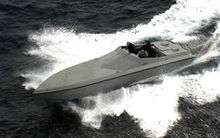Go-fast boat
A go-fast boat is a small, fast boat designed with a long narrow platform and a planing hull to enable it to reach high speeds.

During the era of Prohibition in the United States, these boats joined the ranks of "rum-runners" transferring illegal liquor from larger vessels waiting outside US territorial waters to the mainland. The high speed of such craft enabled them to avoid interception by the Coast Guard. More recently the term "cigarette boat" has replaced the term "rum-runner". The present era of cigarette boats, dating from the 1960s, owes much of their design to boats designed for offshore powerboat racing, particularly by designer and builder Donald Aronow. During this period, these boats were used by drug smugglers to transfer drugs across the Caribbean to the United States.
Construction
A typical go-fast is laid-up using a combination of fibreglass, kevlar and carbon fibre, using a deep "V" style offshore racing hull ranging from 6.1 to 15.2 metres (20 to 50 ft) long, narrow in beam, and equipped with two or more powerful engines, often totalling more than 750 kilowatts (1,000 hp). The boats can typically travel at speeds over 80 knots (150 km/h; 92 mph) in calm waters, over 50 knots (93 km/h) in choppy waters, and maintain 25 knots (46 km/h; 29 mph) in the average 1.5-to-2.1-metre (5 to 7 ft) Caribbean seas. They are heavy enough to cut through higher waves, although slower.
Use
Reflecting their racing heritage, accommodations on these five-passengers-or-fewer boats are minimal. A small low cabin under the foredeck is typical, much smaller than a typical motor yacht of similar size. In addition to racing, most buyers buy these boats for their mystique, immense power, high top speeds, and sleek shape.
Illegal use

These boats are difficult to detect by radar except on flat calm seas or at close range. The United States Coast Guard and the DEA found them to be stealthy, fast, seaworthy, and very difficult to intercept using conventional craft. Because of this, Coast Guards have developed their own high-speed craft and use helicopters equipped with anti-materiel rifles used to disable engines of fleeing boats. The US Coast Guard go-fast boat is a rigid-hulled inflatable boat (RHIB) equipped with radar and powerful engines. The RHIB is armed with several types of non-lethal weapons and an M240 GPMG.
See also
- Narco-submarine
- Poker Run
- Supercavitating propeller
- Tunnel Hull
- Night Train Seizure, one of the largest drug seizures in history.
Books
- Don Aronow: The King of Thunderboat Row. (1994), by Michael Aronow. Write Stuff Enterprises. ISBN 0945903227, ISBN 978-0945903222.
- ’’Secrets of Tunnel Boat Design’’, JDRussell,P.Eng. ISBN 1-894933-30-3
